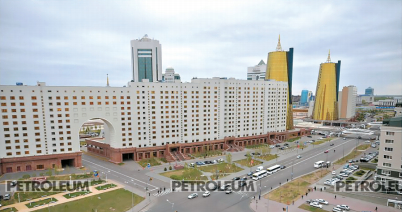Exclusive
The Minister of Energy May run-down

The first report meeting of the new energy Minister Kanat Bozumbayev with the Fuel and Energy Complex (FEC) Public Council was held on May 24th in Astana. During the meeting the Head of the Department spoke in detail about the work of the Ministry of Energy in 2015 and 1st quarter of the current year, and about the development plans for the Department’s three strategic directions. The press-service of the Ministry of Energy has provided the Petroleum journal run-down of the Minister’s report.
The Ministry focuses on three strategic directions:
1. Development of the oil and gas and petrochemical industries.
2. Development of the electric power industry, coal industry and areas where atomic energy is used.
3. Improvement of the quality of the environment.
I will start from the following direction: development of the oil and gas and petrochemical industries.
According to the results of 2015 the annual production volume of oil and condensate has reached 79.5 tons. According to the current data, for the first quarter of this year production volume amounted to 20.1 mln tons, and we are 4% ahead of the current quarterly plan. The plan for 2016 - 74 mln tons, taking into account the oil prices within the 30 dollars per barrel.
With the steady drop in world oil prices in 2015 the rate of development of the oil industry of the country dropped, drilling volumes and investments programs of producing companies have decreased. In order not avoid the decrease in production volume support measures had been taken throughout 2015, including the reduction of the tax burden (MET relief). This work continues today (MET relief, lowering the export customs duties). At the same time, the oil industry remains one of the main sources of budget revenue.
According to the goals set in the National Development Strategy 2050, the further increase in the rate of production is planned. Therefore, we look forward to the stabilization of oil production starting from 2017, followed by an increase. The main production gain in the country will be provided by Tengizchevroil, Karachaganak Petroleum Operating, as well as through commissioning of the Kashagan field.
I will focus on these three projects that are important to the economy and the future of the country.
Tengizchevroil
In 2015 Tengizchevroil hit the record level of oil production - 21,158 mln tons, that had a positive impact on the volume of oil production in the country as a whole. In the coming months a final decision on financing of the Project of TCO future expansion should be adopted. The projected term of commissioning of the new TCO objects is 2022. This will increase oil production to
39 mln tons, and to create about 24 thousand jobs for the time of construction.

Karachaganak
At the Karachaganak in 2015 oil production amounted to 11.9 mln tons, this is 95% from the last year plan, gas production amounted to 18.2 bln cubic meters, this is 101% from the 2015 plan. To extend the period of stable oil production the Concept of further development of Karachaganak is considered today. In cooperation with the contractor the work is carried out aimed at optimization of the concept to maximize revenue for the country. Decision on Karachaganak expansion Project is expected in 2017, and commissioning of new objects in 2022.
Kashagan
Pipeline replacement work and preparation of production facilities for the commissioning are carried out according to the schedule. The control over the readiness of all the permits is conducted. The launching of the Kashagan field is scheduled for the end of 2016.
Subsoil use and oilfield service sector
During a recent visit to the Western region of the country and introduction to production work of TCO, KPO and the Kashagan consortium, meetings were held on future projects expansion, as well as local content issues, with the participation of major subsoil users and Kazakhstani service companies.
The main subject of discussion was the participation of Kazakh service companies in TCO, KPO and Kashagan expansion projects. A number of specific orders was given, aimed at the development of local content:
- - studying the issue of changes in the tender procedures and the inclusion of requirements, which will encourage the creation of joint ventures;
- - acceleration of work on further promotion of Top-10, in that regard the preparation of joint action plans with the operators of major projects (TCO, KPO, NCOC);
- - In cooperation with the operators of major projects the development of a specific plan on replacement of foreign specialists with Kazakhstani personnel in major oil and gas projects;
- - increased implementation of “early tenders” practice;
- - simplification by the KPO, TCO, Kashagan operators of access to the information on upcoming tenders for potential local participants;
- - need to transfer before the end of the year three major oil and gas projects to a unified database, based on already running “Alash” database.
In the oil producing sector today 150 subsoil users are operating, with approximately 60 thous. employees. There is more than 2000 companies in the oilfield service sector, employing at least 170 thous. workers. The share of oilfield service accounts for about 40% of all subsoil users procurements. Therefore, it is important to collaborate with the Public Council on the development prospects of the oilfield service sector.
Oil refining sphere
In 2015, 14.55 mln tons of oil was refined, 2015 plan was 100% achieved. In the first quarter of the current year 2.83 mln tons of oil was refined, 300 thous. ton underrun for the current plan was observed. But currently the refining volume increased, and based on half-year period we are planning to reach planned figures. Plan for 2016 is 14 mln. tons of oil.

The domestic oil products market
The sphere of refining is closely connected to social aspect, since it deals with provision of the domestic market with oil products. In an effort to optimize the circulation of the oil products, in March the Parliament had adopted a law providing for the settlement of the refining issues at the refineries, liberalization of the oil products storage conditions, facilitation of the control of fuel oil circulation.



